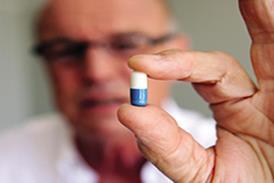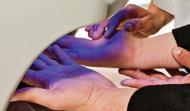Jennifer Trueland talks to two trusts which have overturned the status quo to put in place systems which are aggressively driving up levels of good hand hygiene
Read the main article relating to these case studies here
North East Ambulance Service
Christine McManus reckons that when it comes to hand hygiene, ambulance services are around 10 years behind hospitals.
“The crews are out and about, they are in patients’ homes, they are now doing quite invasive procedures - and have been doing cannulisation for years - but it was never seen as the same issue as it was in hospitals,” she says. “It’s been very challenging, and it still is.”
Ms McManus is infection prevention and control manager at the North East Ambulance Service Trust. The NEAS covers a huge area of the country - 3,230 square miles, and a population of 2.55 million. The trust has around 2,000 staff, three quarters of whom are operational.
‘They’re so pleased that the ambulance is there that they don’t particularly notice if the paramedic has cleaned his hands’
In any one year, crews attend more than 125,000 incidents, carry out almost half a million patient transport service journeys, and almost 20,000 urgent care transport journeys.
That is a lot of patient contact, yet until Ms McManus came into post in 2008, the trust did not have anyone in an infection control role.
“I had worked in primary care before that, and the Cleanyourhands campaign had just come into the community,” she says. “When I joined the trust I realised we were starting from scratch - there was nothing on the vehicles [in terms of gel dispensers] and staff tended to rely on gloves.”
Ms McManus embarked on an ambitious programme to raise awareness of the importance of hand hygiene, and to make it easier for staff to comply. This included placing wall-mounted dispensers in all accident and emergency and patient transport service vehicles. Staff were also given personal issue alcohol hand rub so that they could decontaminate their hands in patients’ homes, or wherever they happened to be.
Hand hygiene training was introduced and is now part of induction, and of mandatory training programmes. Emphasis has been put on the World Health Organisation’s “five moments” approach, to get the message across that it’s important to clean your hands before and after contact with patients.
Heated debate
“Changing the culture among ambulance staff has been very challenging. They had thought that gloves would protect them - getting their gloves off them has been very challenging indeed,” she says. “There’s been a lot of heated discussion and debate - we’re getting there, but it’s still a struggle.”
One of the issues, she says, is that patients and the public do not particularly think of hand hygiene in connection with ambulance staff in the same way as many now do in hospitals. “They’re so pleased that the ambulance is there that they don’t particularly notice if the paramedic has cleaned his hands,” she says.
“And, of course, there are times - dealing with a cardiac arrest, for example - where immediate patient care is the priority, but in the majority of cases good hand hygiene should be possible.”
Ms McManus takes a direct role in measuring compliance with the policy - she actually stands in the region’s various A&E departments and watches the crews go in and out. But she says that carrying out more thorough audit is the next step.
Initial monitoring has included checking how much alcohol gel is being ordered to ensure it is actually being ordered and used. The number of gloves ordered has also been monitored to see if glove use is falling. Early indications were that this was happening, but it is a constant effort to keep progress going, Ms McManus says.
As well as formal training, the trust embarked on a publicity drive. Cleanyourhands posters were distributed to team leaders and staff at all NEAS premises - with a reminder to change them every month. Hand-washing technique posters have been displayed at wash hand basins, and there have been articles and information published in the trust’s in-house magazine.
Senior management support is a must. “The chief executive is really on board with this, and so is the board of the trust,” she says. “And the heat is really on now with the new zero tolerance target on preventable infections.”
Although the ambulance trust itself is not subject to these targets, the hospitals that it works with are - which, in turn, puts pressure on the NEAS. “The last thing I want is for a bacteraemia to be traced back to a paramedic,” she says.
Calderdale and Huddersfield
It was a meeting over a rather nice cup of coffee and some strawberries which helped Carole Hallam make a big breakthrough on hand hygiene - by convincing a director of finance that it would have a real impact on the bottom line.
Ms Hallam, assistant director of infection prevention and control at Calderdale and Huddersfield Foundation Trust, was in the Zalau Emergency Hospital in Romania, where she has been instrumental in changing the practice and culture around hand hygiene.
Ms Hallam, who has been involved with Medical Support in Romania since 2005, has supported the hospital in running campaigns to boost awareness of infection control, and has successfully raised the profile of hand hygiene among staff and management.
“The breakthrough was a very powerful meeting with the director of nursing and the director of finance. I was making the point that very simple hand hygiene had a big impact on healthcare-associated infection, that it reduced length of stay, and that it essentially saved money. When the finance director understood this, she really welcomed the idea and has been very supportive.”
In 2010, a systematic approach to improving hand hygiene was introduced at the 800-bed hospital. This included an audit of hand hygiene facilities in clinical areas, training and education, observation and feedback, and awareness raising.
The audit found there were only 15 paper towel dispensers, and that nine were empty; there were 206 liquid soap dispensers, of which 39 (19 per cent) were broken. There were 62 alcohol containers and dispensers, which had all been provided since the previous year, but the most commonly used alcohol containers did not include a pump to control the amount dispensed. A cost-benefits analysis showed that in the A&E department alone, around £913 per year could be saved if wall-mounted dispensers applying a controlled amount of alcohol were fitted.
“Staff were really enthusiastic, and the director of nursing is really passionate about it - a real change agent,” says Ms Hallam.
Having won an educational grant from Deb, Ms Hallam and colleagues were able to buy posters to raise awareness of hand hygiene, and also to buy an ultraviolet light box to aid with training.
“That’s been a really successful training aid in Romania, because it’s quite novel and people like it,” she says, explaining that people can see how good their hand cleaning technique is by how well they manage to wash a special cream off their hands - any traces will show up under the UV light.
In 2010, the hospital was one of three in Romania to sign up to the WHO Save Lives - Clean Your Hands campaign. During the week-long visit from Ms Hallam and colleagues, ward sisters and other nurses were trained in the “five moments for hand hygiene” (before patient care, before aseptic technique, after contact with blood and body fluids, after direct contact with the patient, and after contact with the patient’s immediate environment).
Great strides
Since then, momentum has been maintained by, for example, a competition to design appropriate posters, which attracted 27 high-quality entries within four days.
Next week, Ms Hallam will return to Romania to take part in a national conference to be held in Zalau. The two-day event on sterilisation and infection control will include the launch of an infection control text book - called Preventing Patient Harm - which has been written by Ms Hallam and colleagues, and translated into Romanian.
Back home in West Yorkshire and hand hygiene clearly remains high on Ms Hallam’s agenda - and on that of her employers. An infection control nurse for 16 years, she has seen great strides in that time - partly due to top-down initiatives like targets, she says.
“I don’t think I particularly welcomed targets when they first came out, but now I don’t think we’d have achieved what we have without them,” she says.
“Some initiatives have really helped to make a difference - such as the ‘bare below the elbow’ policy. I think that’s a really visible statement and sends out the message to everyone - staff and visitors - that this is an issue that matters. It’s really saying: ‘I’m signed up to this’ - and so we should be.”




























No comments yet